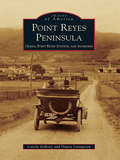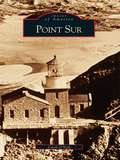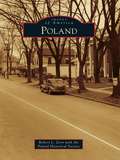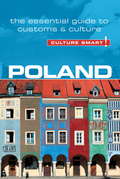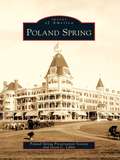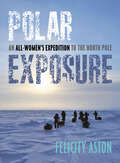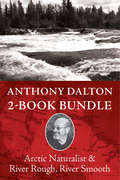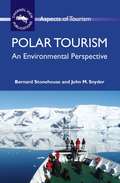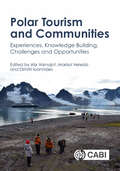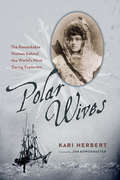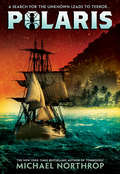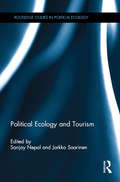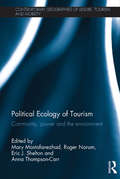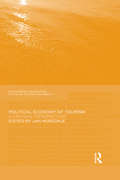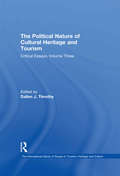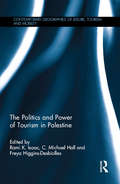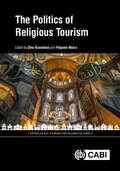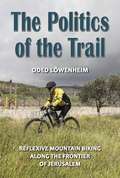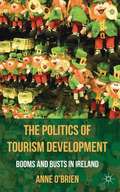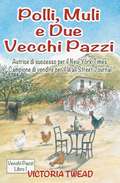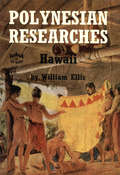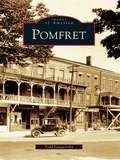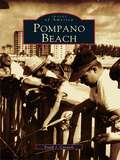- Table View
- List View
Point Reyes Peninsula: Olema, Point Reyes Station, and Inverness
by Dewey Livingston Carola DerooyThe Point Reyes Peninsula has a rich history encompassing thriving Native American settlements, visits by Francis Drake and Spanish explorers, dramatic shipwrecks, Mexican rancheros, famous dairy farms, railroads, and one of the country's most spectacular lighthouses. These historical facets spawned the three small towns of Olema, Point Reyes Station, and Inverness; each is unique with its own distinctive foundations. Most of the land is now within Point Reyes National Seashore, a refuge created during the Kennedy administration and now one of the more popular destinations on the California coast. The unique geography of the forest, bay, and ocean environments and the abundant wildlife in Point Reyes offers fine scenery, diverse recreational opportunities, and good food and lodging, while the towns retain their old-time character.
Point Sur (Images of America)
by Carol O’neilPoint Sur Lightstation was carved out of solid volcanic rock more than a century ago. When the light was turned on in 1889, no towns or roads were nearby to support the four families that lived atop the giant "moro" rock located just offshore in Big Sur, California. These vintage images tell the story of Pt. Sur Lightstation with its state-of-the-art lighthouse and fog signal system, and the lightkeepers and their families who kept it operating until 1974. The remote location and treacherous coast were constant adversaries. Today, Pt. Sur's lighthouse is automated. The vacant lightstation buildings are a ghost town that reminds us of our proud maritime heritage and the hearty souls who helped light the way.
The Poison Tree: A True Story Of Family Violence And Revenge
by Alan PrendergastPrendergast, who for Rolling Stone covered the trials of teenagers Richard and Deborah Jahnke in Wyoming for the 1982 murder of their father, has produced an objective, affecting account of the case. A borderline psychotic, Jahnke senior subjected his wife and children to abuse both physical and psychological and, for a time, made sexual advances toward his daughter. Their residence became a house of terror, with the mother the most terrified of all, according to Prendergast. The children's feeble and intermittent attempts to acquaint outsiders with their situation were of no avail. Finally, with his sister's semiconnivance, Richard shot his father. The trials of the two, held separately, showed American justice at its worst: a prosecutor more interested in convictions than in finding the truth, and two inept and hidebound judges, one of whom would not admit evidence of child abuse. Deborah's sentence has now been commuted to one year of probation and Richard has been released on parole. A searing, convincing indictment.
Poland (Images of America)
by Poland Historical Society Robert L. ZornPoland Township was the first township to be chartered in the Connecticut Western Reserve and was settled by Connecticut pioneers. Jonathan Fowler founded the township and owned an inn near Yellow Creek. This building still stands and is Poland's oldest structure. An important stagecoach stop on the main highway between Cleveland and Pittsburgh, Poland's population soared in the early 1800s. The first blast furnace west of the Alleghenies was built here, and William McGuffey, of the famous McGuffey readers, taught school in Poland before going on to national fame. Poland's education legacy did not stop there. Poland's College Street was home to eight colleges at one time, including the Poland Academy, Poland Seminary, Poland Female College, Poland Law School, and the Poland Medical College. William McKinley, the 25th president of the United States, was a graduate of the Poland Academy and Senator, and later Ambassador William Calhoun graduated from the Poland Seminary. Poland today maintains a quaint New England atmosphere, showing its colonial heritage.
Poland - Culture Smart!
by Greg AllenCulture Smart! provides essential information on attitudes, beliefs and behavior in different countries, ensuring that you arrive at your destination aware of basic manners, common courtesies, and sensitive issues. These concise guides tell you what to expect, how to behave, and how to establish a rapport with your hosts. This inside knowledge will enable you to steer clear of embarrassing gaffes and mistakes, feel confident in unfamiliar situations, and develop trust, friendships, and successful business relationships.Culture Smart! offers illuminating insights into the culture and society of a particular country. It will help you to turn your visit-whether on business or for pleasure-into a memorable and enriching experience. Contents include* customs, values, and traditions* historical, religious, and political background* life at home* leisure, social, and cultural life* eating and drinking* do's, don'ts, and taboos* business practices* communication, spoken and unspoken"Culture Smart has come to the rescue of hapless travellers." Sunday Times Travel"... the perfect introduction to the weird, wonderful and downright odd quirks and customs of various countries." Global Travel"...full of fascinating-as well as common-sense-tips to help you avoid embarrassing faux pas." Observer"...as useful as they are entertaining." Easyjet Magazine"...offer glimpses into the psyche of a faraway world." New York Times
Poland Spring (Images of America)
by Jason C. Libby Poland Spring Preservation SocietyIn 1794, Jabez Ricker traded his land in Alfred to the local Shaker community for property in present-day Poland. Shortly after his arrival, travelers came looking for a place to stay, and the Ricker family began its first inn. In 1844, Hiram Ricker, a grandson of Jabez, discovered the curative powers of the mineral spring on the property and began to share the water with family and friends. Within another half century, sales of the water prompted the building of the Poland Spring House, a summer hotel that eventually had more than 500 rooms and the first golf course at a resort in the country; the purchase of the Maine State Building from the 1893 World's Columbian Exposition in Chicago; and many other ingenious and trend-setting innovations.
Polar Exposure: An All-Women's Expedition to the North Pole
by Felicity AstonThis inspiring account of a diverse all-women&’s expedition to the North Pole reveals the highs and lows of record-breaking, modern-day exploration.&“A wonderful collaboration both on the Arctic ice and onto the page. Each team members voice arises to offer a view beyond the physical giving us the essence of a unique adventure.&” Ann Bancroft, first woman to reach the North Pole and coauthor of No Horizon Is So Far: Two Women and Their Historic Journey across AntarcticaWhen British Explorer Felicity Aston put out an open call for women with little to no experience willing to brave the elements on an expedition to the North Pole, she was stunned to have over 1000 applicants. After narrowing it down to ten women from ten different countries—some of whom had never seen snow before—the team spent the next two years training for this unique opportunity.Each member of the team tells part of the story in her own words, chronicling their grueling preparation in Iceland and Oman, the anticipation for the journey, and the terrifying conditions of the Arctic. Set against a backdrop of Arctic pack ice that is thinner, newer, and less stable than ever before due to climate change—the team face the realities of hungry polar bears, extreme temperatures, and the possibility that anything and everything could go wrong at any moment.Aston beautifully weaves each woman&’s account into the greater expedition narrative, reminding readers of the teamwork needed to complete such a feat. Over 60 stunning photographs illustrate the journey, illuminating the breathtaking landscape along with the joy, pain, and determination of these ten women.Polar Exposure is a powerful celebration of the perseverance of women in science, sports, and exploration that sheds light on all that it takes to reach the top of the world.
Polar Region Explorers 2-Book Bundle: River Rough, River Smooth / Arctic Naturalist
by Anthony DaltonPresenting a special 2-book bundle of Anthony Dalton’s outstanding writing on Canada's polar regions, their history, and their greatest explorers. “Dalton does an excellent job … a very enjoyable read.”— Bios Newsletter Includes: River Rough, River Smooth Manitoba’s Hayes River runs over 600 km, from Norway House to Hudson Bay. Traditionally used for transport and hunting by the indigenous Cree, it became a major fur trade route from the 17th to 19th centuries. This is the account of the author’s journey on the Hayes in the company of modern-day voyageurs reliving the past. Arctic Naturalist J. Dewey Soper was the last of the great pioneer naturalists in Canada, and spent many years in the Arctic, where he discovered the breeding grounds of the blue goose and charted the final unknown region of Baffin Islands coastline.
Polar Tourism
by John Snyder Bernard StonehouseTourism throughout the world raises environmental issues that are often concerned with conflicting rights and responsibilities: the inherent right of mankind to travel, the no-less inherent right of indigenous people to guard their environmental heritage, and the responsibility of governments - local, national or (in the unique case of Antarctica) international - to protect environments over which they exercise stewardship. Additionally, the presence of international commercial enterprises, especially marine and other mass transport modes, represent unique governance challenges. This book deals mainly with environmental issues and the management implications arising from polar tourism, one of the fastest-growing sectors of world tourism. However, many of the issues discussed here arise no less urgently in temperate and tropical wilderness areas, and indeed in any region where sensitive environments are subjected to mass tourism. The principles and guidelines discussed here are of interest and practical use in tourism studies generally.
Polar Tourism and Communities: Experiences, Knowledge Building, Challenges and Opportunities
by Alix Varnajot, Marisol Vereda & Dimitri IoannidesPrior to the outbreak of the coronavirus pandemic in 2020, the Arctic and Antarctic regions were experiencing significant growth in tourist arrivals. In the aftermath of this global crisis, the tourism industry has rebounded and the number of tourists visiting the polar regions is expected to keep growing significantly in the coming years. Remote regions are increasingly accessible as tourism actors develop technologies, diversify activities and itineraries, and climate change worsens. In the Arctic, tourism now takes place year-round through various modalities, ranging from exclusive icebreaker expeditions to the North Pole to mass tourism practices in several destinations such as Rovaniemi, Reykjavik, Longyearbyen or Skagway, wherein tourism not only brings opportunities, but also new challenges to local communities. Meanwhile, gateway cities to Antarctica such as Ushuaia and its inhabitants are set to recover from the severe adverse effects due to the virtual standstill of tourism in the region. This book fills the gap in literature on polar tourism and communities. Through several examples encompassing the Arctic and Antarctica, various chapters examine how both the tourism industry and various communities impact and influence each other from economic, sociocultural, political and environmental perspectives. The contents provide a general perspective regarding polar tourism and chapters focusing on challenges and/or experiences of the communities that are related to tourism in the polar regions and delivers: · Exploration of the complex interactions between polar tourism and local communities · Coverage of a broad range of topics including safety, environmental care, increase in the number of visitors, and the pursuit of new experiences at the farthest extremes of the world. Overall, this book provides a unique and timely analysis of the complex interactions between polar tourism and local communities and could be of interest to advanced-level students and researchers in tourism studies and polar geographies.
Polar Wives: The Remarkable Women behind the World's Most Daring Explorers
by Jon Bowermaster Kari HerbertPolar explorers were the superstars of the "heroic age" of exploration, a period spanning the Victorian and Edwardian eras. In this engaging book, author Kari Herbert explores the unpredictable, often heartbreaking lives of seven remarkable women who married world-famous polar explorers.As the daughter of a pioneering polar explorer, Herbert brings a unique perspective to these stories of polar exploration. In her portraits of the gifted sculptor Kathleen Scott; eccentric traveller Jane Franklin; spirited poet Eleanor Anne Franklin; Jo Peary, the first white woman to travel and give birth in the High Arctic; talented and determined Emily Shackleton; Norwegian singer Eva Nansen; and her own mother, adventurer Marie Herbert, Karie Herbert blends deeply personal accounts of longing, betrayal, and hope with stories of peril and adventure.Herbert illuminates the essential role the women played in supporting, publicizing, defending, and even financing their husbands' expeditions. She follows these "polar wives" not only to the polar wastelands but through wartorn Macedonia, the lawless outback of Australia, and the plague-riddled ancient cities of the Holy Land.With extracts from previously unpublished historic journals and letters, Polar Wives brings together for the first time, the compelling stories of seven adventurous women.
Polaris
by Michael NorthropA crew of children must pilot a ship across unfamiliar seas while a strange creature lurks belowdecks in this fast-paced survival story from New York Times bestselling author Michael Northrop.Alone at sea, with only the stars to guide them...The proud sailing ship Polaris is on a mission to explore new lands, and its crew is eager to bring their discoveries back home. But when half the landing party fails to return from the Amazon jungle, the tensions lead to a bloody mutiny. The remaining adults abandon ship, leaving behind a cabin boy, a botanist's assistant, and a handful of deckhands -- none of them older than twelve. Troubled by whispers of a strange tropical illness and rumors of a wild beast lurking onshore, the young sailors are desperate to steer the vessel to safety. When one of their own already missing and a strange smell drifting up from below deck, the novice crew begins to suspect that someone -- or something -- else is onboard. Having steeled themselves for the treacherous journey home, they now have more to fear than the raging waters of the Atlantic...
Political Ecology and Tourism (Routledge Studies in Political Ecology)
by Sanjay Nepal Jarkko SaarinenPolitical ecology explicitly addresses the relations between the social and the natural, arguing that social and environmental conditions are deeply and inextricably linked. Its emphasis on the material state of nature as the outcome of political processes, as well as the construction and understanding of nature itself as political is greatly relevant to tourism. Very few tourism scholars have used political ecology as a lens to examine tourism-centric natural resource management issues. This book brings together experts in the field, with a foreword from Piers Blaikie, to provide a global exploration of the application of political ecology to tourism. It addresses the underlying issues of power, ownership, and policies that determine the ways in which tourism development decisions are made and implemented. Furthermore, contributions document the complex array of relationships between tourism stakeholders, including indigenous communities, and multiple scales of potential conflicts and compromises. This groundbreaking book covers 15 contributions organized around four cross-cutting themes of communities and livelihoods; class, representation, and power; dispossession and displacement; and, environmental justice and community empowerment. This book will be of great interest to students and scholars in tourism, geography, anthropology, sociology, environmental studies, and natural resources management.
Political Ecology of Tourism: Community, power and the environment (Contemporary Geographies of Leisure, Tourism and Mobility)
by Mary Mostafanezhad Roger Norum Eric J. Shelton Anna Thompson-CarrWhy has political ecology been assigned so little attention in tourism studies, despite its broad and critical interrogation of environment and politics? As the first full-length treatment of a political ecology of tourism, the collection addresses this lacuna and calls for the further establishment of this emerging interdisciplinary subfield. Drawing on recent trends in geography, anthropology, and environmental and tourism studies, Political Ecology of Tourism: Communities, Power and the Environment employs a political ecology approach to the analysis of tourism through three interrelated themes: Communities and Power, Conservation and Control, and Development and Conflict. While geographically broad in scope—with chapters that span Central and South America to Africa, and South, Southeast, and East Asia to Europe and Greenland—the collection illustrates how tourism-related environmental challenges are shared across prodigious geographical distances, while also attending to the nuanced ways they materialize in local contexts and therefore demand the historically situated, place-based and multi-scalar approach of political ecology. This collection advances our understanding of the role of political, economic and environmental concerns in tourism practice. It offers readers a political ecology framework from which to address tourism-related issues and themes such as development, identity politics, environmental subjectivities, environmental degradation, land and resources conflict, and indigenous ecologies. Finally, the collection is bookended by a pair of essays from two of the most distinguished scholars working in the subfield: Rosaleen Duffy (foreword) and James Igoe (afterword). This collection will be valuable reading for scholars and practitioners alike who share a critical interest in the intersection of tourism, politics and the environment
Political Economy of Tourism: A Critical Perspective (Contemporary Geographies of Leisure, Tourism and Mobility)
by Jan MosedalePolitical economy, in its various guises and transfigurations, is a research philosophy that presents both social commentary and theoretical progress and is concerned with a number of different topics: politics, regulation and governance, production systems, social relations, inequality and development amongst many others. As a critical theory, political economy seeks to provide an understanding of societies – and of the structures and social relations that form them – in order to evoke social change toward more equitable conditions. Despite the early influence of critical development studies and political economy on tourism research, political economy has received relatively little attention in tourism research. Political Economy and Tourism the first volume to bring together different theoretical perspectives and discourse in political economy related to tourism. Written by leading scholars, the text is organised into three sequential Parts, linked by the principle that ‘the political’ and ‘the economic’ are intimately connected. Part one presents different approaches to political economy, including Marxist political economy, regulation, comparative political economy, commodity chain research and alternative political economies; Part two links key themes of political economy, such as class, gender, labour, development and consumption, to tourism; and Part three examines the political economy at various geographical scales and focuses on the outcomes and processes of the political act of planning and managing tourism production. This engaging volume provides insights and alternative critical perspectives on political economy theory to expand discussions of tourism development and policy in the future. Political Economy and Tourism is a valuable text for students, researchers and academics interested in Tourism and related disciplines.
The Political Nature of Cultural Heritage and Tourism: Critical Essays, Volume Three (The International Library of Essays in Tourism, Heritage and Culture #Vol. 3)
by Dallen J. TimothyThis three volume reference series provides an authoritative and comprehensive set of volumes collecting together the most influential articles and papers on tourism, heritage and culture. The papers have been selected and introduced by Dallen Timothy, one of the leading international scholars in tourism research. The third volume 'The Political Nature of Cultural Heritage and Tourism' addresses contemporary issues such as heritage dissonance, the debate on authenticity, conflict, and contested heritage. Sold individually and as a set, this series will prove an essential reference work for scholars and students in geography, tourism and heritage studies, cultural studies and beyond.
The Politics and Power of Tourism in Palestine (Contemporary Geographies of Leisure, Tourism and Mobility)
by C. Michael Hall Rami K. Isaac Freya Higgins-DesbiollesTourism in Palestine has been receiving an increasingly important profile given its economic and religious importance and the significant role it plays in Israeli-Palestinian relations, representation of Palestinian statehood and identity, and wider Middle Eastern politics. Nevertheless, Palestine, like much of the Middle East as a whole, remains extremely underrepresented in tourism literature. This title aims to fill this void by being the first book dedicated to exploring the significance of tourism in relationship to Palestine. The book examines the role of tourism in Palestine at three main levels. First, it provides an overview of destination management and marketing issues for the tourism industry in Palestine and addresses not only the visitor markets and the economic significance of tourism but also the realities of the difficulties of destination management, marketing and promotion of the Palestinian state. Second, it provides a series chapters and case studies that interrogate not only the various forms of tourism in Palestine but also its economic, social, environmental and spiritual importance. This section also conveys a dimension to tourism in Palestine that is not usually appreciated in the Western mainstream media. The third section indicates the way in which tourism in Palestine highlights broader questions and debates in tourism studies and the way in which travel in the region is framed in wider discourses. A significant dimension of the book is the attention it gives to the different voices of stakeholders in Palestinian tourism at varying levels of scale. This timely volume will offer the reader significant insight into the challenges and issues of tourism in this area now and in the future. It will benefit those interested in tourism, Middle East studies, politics, economics, development studies and geography.
The Politics of Heritage in Africa
by Derek R. Peterson Kodzo Gavua Ciraj Rassool Derek R. Peterson Kodzo GavuaHeritage work has had a uniquely wide currency in Africa's politics. Secure within the pages of books, encoded in legal statutes, encased in glass display cases and enacted in the panoply of court ritual, the artefacts produced by the heritage domain have become a resource for government administration, a library for traditionalists and a marketable source of value for cultural entrepreneurs. The Politics of Heritage in Africa draws together disparate fields of study - history, archaeology, linguistics, the performing arts and cinema - to show how the lifeways of the past were made into capital, a store of authentic knowledge that political and cultural entrepreneurs could draw from. This book shows African heritage to be a mode of political organisation, a means by which the relics of the past are shored up, reconstructed and revalued as commodities, as tradition, as morality or as patrimony.
The Politics of Religious Tourism (CABI Religious Tourism and Pilgrimage Series)
by Silvia Aulet Serrallonga Valentina Castronuovo Stefania Cerutti Charlotte Lee Panagiota Manoli Dane Munro Dimitrios Mylonopoulos Dr Daniel H Olsen Masahiro Omae Maria Angelica Orozco Jorge Olleros-Rodriguez Spyridon Parthenis Dr Elisa Piva Xosé M. Santos Francisco Singul Associate Professor Anna TronoAddressing a dearth of literature in this area, this book provides a comprehensive overview and framework of study of the politics of religious tourism. Existing work shows awareness that politics is present but the approach has been one of benign neglect, and/or a priori assumptions about the role of politics in the management of sacred sites. Previous literature is fragmented into various perspectives and approaches that best serve different disciplinary interests. By understanding the politics of religious tourism through the various perspectives and approaches from the discipline of political science, law, public policy, and other fields, this book: · Focuses on how power is exercised regarding religious tourism. · Looks at the governing institutions of religious tourism including the role of relevant governmental bodies such as ministries of tourism or national tourism boards, ministries of religion and/or culture. · Covers the role and influence of religious governing institutions, such as state-supported church/mosque officials, and universities. This book will be of great interest to researchers and students of religious tourism, pilgrimage, as well as related subjects such as political science, economics, sociology, tourism, law studies, and religious studies.
The Politics Of The Trail: Reflexive Mountain Biking Along The Frontier Of Jerusalem
by Oded LowenheimEach day, as Oded Löwenheim commutes by mountain bike along dirt trails and wadis in the hills of Jerusalem to Hebrew University, he feels a strong emotional connection to his surroundings. But for him this connection also generates, paradoxically, feelings and emotions of confusion and estrangement. In The Politics of the Trail, Löwenheim confronts this tension by focusing on his encounters with three places along the trail: the separation fence between Israel and the Palestinians; the ruins of the Palestinian village Qalunya, demolished in 1948; and the trail connecting the largest 9/11 memorial site outside the U. S. with a top-secret nuclear-proof bunker for the Israeli cabinet. He shares the stories of the people he meets along the way and considers how his own subjectivity is shaped by the landscape and culture of conflict. Moreover, he deconstructs, challenges, and resists the concepts and institutions that constitute such a culture and invites conversation about the idea of conflict as a culture.
The Politics of Tourism Development: Booms and Busts in Ireland
by Anne O’BrienMoving beyond both tourism and politics literatures' current understandings of how tourism is developed, this book offers an original theory of interlocking regimes to account for the manner in which public and private bodies either facilitate or prevent development within tourism.
Polli, muli e due vecchi pazzi
by Debora Serrentino Victoria Twead**Tra i 10 migliori autori secondo il Wall Street Journal** **Miglior autrice secondo il New York Times** Se Joe e Vicky avessero saputo cosa volesse DAVVERO dire trasferirsi in un piccolo villaggio di montagna in Andalusia, probabilmente avrebbero esitato... Non avevano idea dello shock culturale in serbo. Non avevano idea che sarebbero diventati riluttanti allevatori di polli e che avrebbero posseduto il più pericoloso galletto di Spagna. Non avevano idea che avrebbero aiutato a catturare in avvoltoio o che sarebbero stati salvati da una mula. Rimarranno o torneranno alla relativa sanità mentale dell'Inghilterra? Include le ricette spagnole donate dalla signore del villaggio.
Polynesian Researches: Hawaii
by William EllisPolynesian Researches:Hawaii is the famous record of the author's visit to the Hawaiian Islands in the early nineteenth century. <P><P>It includes an account of Hawaiian history, government, religion , warfare, and traditions- a general survey of Hawaiian life. More than this, it is the author's personal observations of Hawaiian manners and customs and is invaluable to anyone interested in old Hawaii.The author, Rev. William Ellis, lived in Polynesia as a missionary from 1817 to 1825. He spent much of his time in Tahiti and soon became fluent in the language. Before returning to England, he seized an opportunity to visit the Hawaiian Islands. He was soon able to talk with the natives in the Hawaiian language and made a tour of the island of Hawaii. On his tour he talked with chiefs, common people Hawaiian holy-men, and divinely possessed oracles. He climbed volcanoes, rode canoes, and visited the sight of Captain Cook's death. Besides the description of his tour, this book includes an account of Maui, Kahoolawe, Molokini, Lani, Molokai, Oahu, Kauai, Hiihau, and Kaula.The book is full of interesting descriptions of the author's encounters with Hawaiians. It is fast-moving and easy-reading. This book, an encyclopedic account of traditional Hawaii.
Pomfret (Images of America)
by Todd LangworthyWhen shipbuilder Zattu Cushing passed through western New York State at the beginning of the 19th century, he saw a beautiful area that had great potential for settlement. He vowed to come back and settle with his family as soon as possible. In 1805, Cushing came back and became the first permanent settler in what was to become the town of Pomfret. Pomfret quickly grew, attracting people of great talent to the small settlement situated on Canadaway Creek near Lake Erie. Soon the village of Fredonia was chartered within the town, leading to even more fantastic growth. Pomfret became a town of many firsts, as well as the home of countless noteworthy families. Today Pomfret is a vibrant community that is proud of its past and excited about its future.
Pompano Beach
by Frank J. CavaioliLocated on Florida's Atlantic Coast midway between Palm Beach and Miami, Pompano Beach marks the northern boundary of the Florida reef at the outlet from the Intracoastal Waterway to the ocean. Incorporated in 1908, the city is now home to more than 82,000 residents, who consider their community, with its historic buildings, pristine beaches, and comfortable lifestyle, the "Gem of the Gold Coast."The completion of the Pompano Canal in 1890 and the arrival of the Flagler Florida East Coast Railway in 1896 provided the basis for the early development around Lettuce Lake, now Lake Santa Barbara, and Pompano Beach's rich farmland attracted the area's first settlers. These stalwart men and women faced with determination the challenges of natural disasters and economic uncertainty and carved their prosperous community out of the harsh Florida landscape. Prominent people, such as the McNab brothers, George L. Blount, the Garner family, George and Mary Butler, Blanche Ely, the Rolle family, and others, took part in the developing tale of Pompano Beach, while local landmarks and events, such as the Kester Cottages, the State Farmers' Market, Pompano Harness Park, Goodyear Blimp, the Holiday Boat Parade, the Broward County Fair, and Pioneer Days, helped to shape the area's rich heritage. Featuring over 200 vintage photographs of such people and places, this pictorial retrospective captures, in word and image, the scenes of Pompano Beach's unique history.
